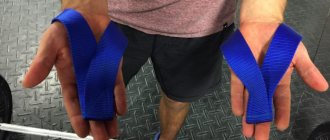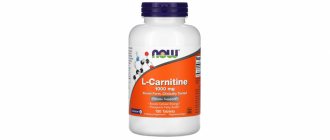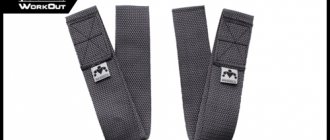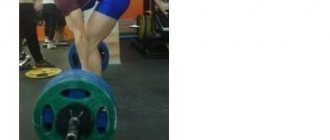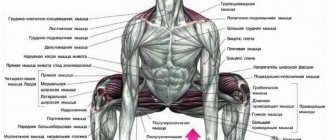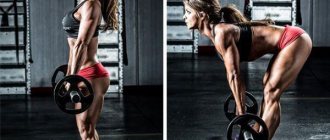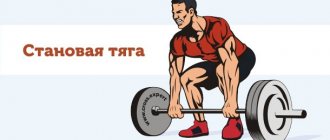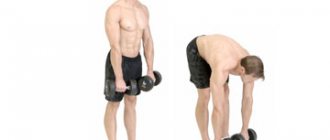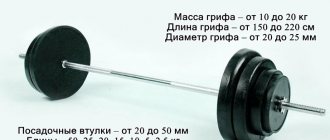Bodybuilding and powerlifting are hard work that can be made easier to some extent. One of the widespread “helpers” of a weightlifter is belts (straps) for deadlifting.
If you ask gym goers, you will hear diametrically opposed opinions about this accessory. Some say that it is not only unnecessary, but even harmful. Some argue that without belts you cannot achieve impressive results in deadlifts, pull-ups and a number of other exercises.
Typically, both are right.
- Yes, traction straps can cause harm. Because of them, grip strength develops more slowly, and the strength of the wrists, forearms, and hands decreases. The reason is that in a normal situation, these loads would be placed on your body, which would promote muscle development. Using belts makes your arms a little weaker, which can lead to injury when lifting heavy weights.
- At the same time, belts bring great benefits. Thanks to them, you can continue training when you are very tired and achieve intensive muscle growth. Accessories will help you cope with heavy lifts when the “natural” strength of your hands is no longer enough.
What are traction straps?
In simple terminology, straps are small pieces of belts that are used to redistribute pressure when performing exercises with a barbell and dumbbells . This is one of the main elements of insurance for a bodybuilder. They are also regularly used by gym goers and strength athletes.
However, what are they used for? What are their disadvantages?
Deadlift belt. Effect on the lower back
You often hear about using a belt for deadlifts. However, not everyone knows that use is only advisable when working with maximum weight.
Deadlift Belt
When working with light weights, it is not recommended to use it, as it works the abdominal muscles. The force acting on the spine at this moment remains the same and does not increase. Muscle development occurs not only when performing deadlifts, but also when bending over.
However, in other cases, the belt protects the spine from ruptures and pinching. By creating compression in the abdominal cavity, the torso is securely fixed. It is recommended to wear it under the ribs.
Made from genuine leather, belt thickness no more than 13 mm.
Why do you need straps in the gym?
Jason Ferrugia once wrote: “No straps, no traps.” Truer words have probably never been written by anyone .
Many people online defend the fact that straps are not an effective sports accessory and should not be used. From a certain point of view, they are right, because straps are not allowed in powerlifting, unlike other strength sports. If you use them correctly and selectively during training, straps will help with increasing strength and muscle mass . When it comes to the use of straps by athletes who do not participate in competitions, then the straps will undoubtedly help to gain strength and muscle size.
One of their advantages is that, thanks to the straps, the measured exclusion of the muscles of the forearms and hands from work allows you to maintain the integrity of the wrist joint. This is the rule you should follow in the gym. Answer two simple questions:
1. What muscle is the exercise targeting? 2. Which muscles get tired first?
If the answer to each of these questions is not the same, your training is not effective . Doing the exercises should not be too easy. So, if you intend to increase the size and strength of a specific muscle group, and straps only help you with this , then use them!
Example of exercises using straps:
• Bent-over row • Barbell row to the chin • Deadlift • Romanian deadlift (wide grip deadlift) • Block deadlift
All of these exercises are aimed at increasing muscle mass and strength in the upper back, trapezius and hamstrings. So, there's no reason not to use straps, especially if you can't hold a dumbbell long enough to work the target muscle group.
Traction straps. When your hands can no longer do it, but your head wants to 
Continuing the sports theme, let's talk about traction straps. The thing is highly specialized and extremely simple. As a rule, beginners do not need it, but sooner or later beginners cease to be so... What are athletic straps for? When performing exercises with large weights, the hands can no longer cope with the weight of the projectile and the fingers begin to unclench. This leads to a reduction in the number of approaches per exercise and limitation of working weights. Which exercises (at a minimum) may require straps:
1. Deadlift 2. Bent-over row 3. Pull-up on the horizontal bar with weights.
The presence of straps helps to transfer part of the load to the wrist, increase achievements in exercises, and therefore continue muscle growth.
What types of straps are there? For starters, they are made from different materials. As a rule, these are cotton, synthetics and leather. Cotton is softer, but it stretches over time, synthetic does not stretch, but it is stiffer, and leather is somewhere in the middle.
1. The most ordinary of the belt, not sewn at all
2. From a belt, sewn into a loop
3. Sewn into a ring, with soft padding and perpendicular fastening
4. With steel hook
What is the difference between them? In fact, there is not that much of it. We can probably say that it’s just that the straps are a little more difficult to wrap around the projectile at first.
But over time, this becomes a quick, familiar and inconvenient procedure. But since beginners try to purchase their first straps as simple as possible, from the point of view of convenience, they take other types of straps, and then stay with them.
Belts sewn into a loop are the most common, because... they are easy to make yourself and are comfortable if made from cotton. They are more convenient to use than just belts. Synthetic loop belts cut your hands and are therefore not as common. Winding them is even easier, but putting the loop on itself requires a little attention. The loop is worn differently on the right and left hands.
Belts with a steel hook do not require any winding, but they have one significant drawback that limits their use. The apparatus (barbell or dumbbell) cannot be released by opening your palm. This adds risk if something goes wrong during the exercise.
And finally, the heroes of the review: Belts with an adjustable ring strap, padded with soft fabric
They are fastened with Velcro, with a fairly solid metal ring.
There is a soft pad around the wrist. They cannot be put on incorrectly, and the fixation around the wrist is not done by tightening the loop, but can be limited to a comfortable level. I personally found this more convenient.
How to use belts? Yes, it’s very simple, and it’s better to see once than to hear or read a hundred times.
And as a resume. The straps are good, they helped me move to the next level in the deadlift))) It’s convenient to use, it’s comfortable for my wrists.
Good luck in sports, joy and health!
Types of straps and their advantages and disadvantages
There are three main types of straps – traction loops, webbing, and hooks . We will describe the individual advantages and disadvantages of these types.
Hinges with lock
Advantages:
• This is the simplest type of straps, it comes in different lengths and from different materials (fabric, leather).
• Lock for secure wrapping around the wrist.
Flaws:
• Sometimes it can be more difficult to wrap the remaining hanging fabric around the barbell, especially with one hand.
• Fabric that hangs may interfere with lifting the barbell. This is why they are not usually used in competitions.
Straps
Advantages:
• The closed loop allows you to quickly and easily attach the strap to the barbell.
• If you can’t lift the weight, it’s easier to remove them.
Flaws:
• Less material means less secure grip.
• Do not wrap them tightly around your wrist.
Hooks
Advantages:
• No need to wind.
• Convenient and practical for exercise.
Flaws:
• You can’t grip the bar so tightly.
• Not suitable for all types of fingerboards.
Deadlift Shoes
The main task of shoes is to support the ankle and securely fix the foot. Thanks to it, the athlete should receive protection from high loads. It also helps prevent the development of flat feet.
Barbells for deadlifts
Special boots are a must-have attribute in the equipment of any professional athlete.
Shoes must have a buckle to secure the foot and a ribbed sole
It should include not only orthopedic properties, but above all, be durable. Good lateral support of the foot is important. Even if the athlete puts his feet wide, they will not slide.
Special sneakers for deadlifts made of genuine leather
Material for production: genuine leather, rubberized sole.
Not all athletes know about the availability of such shoes, and often use regular sneakers. This is acceptable, but until the athlete’s weight reaches a certain threshold.
Regular shoes cannot guarantee safety. It is not intended to be used for such purposes.
Deadlift straps. How to use
Using straps while deadlifting can reduce the stress on your joints. Thanks to them, the muscles do not become overstrained or overworked.
Deadlift Straps
Beginner athletes should not use them. They are necessary when working with heavy weights. Continued use of the clamp will not increase your grip strength. The wrists need to be trained to have grip strength.
The free part of the strap should be from 20 cm
Rules of use:
- The free part of the strap should be from 20 cm.
- For proper fixation, the middle part of the belt should be on the back of the hand.
- Make sure that the belt does not twist in the locked position.
Deadlift hooks
A hook is a must-have for powerlifting. The load on the forearm muscles is reduced, resulting in a stronger grip on the bar.
Deadlift hooks
By using a hook you don’t have to worry about the condition of your hands. Progress from classes will accelerate.
Hands are protected with hooks
They are made from genuine, durable leather. The hook itself is made of steel, capable of supporting up to 150 kg. Thanks to the soft inserts, the pressure on the hands is reduced several times.
